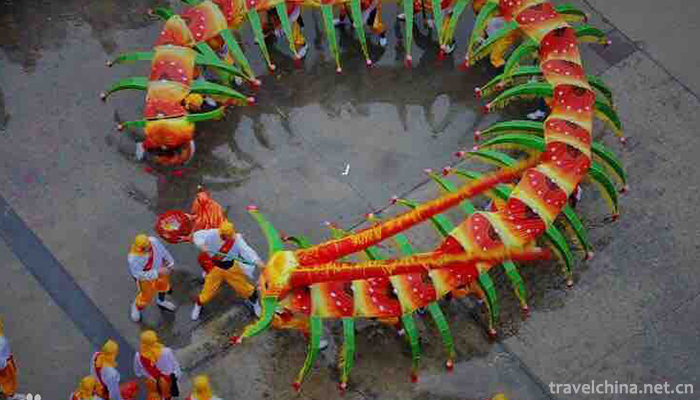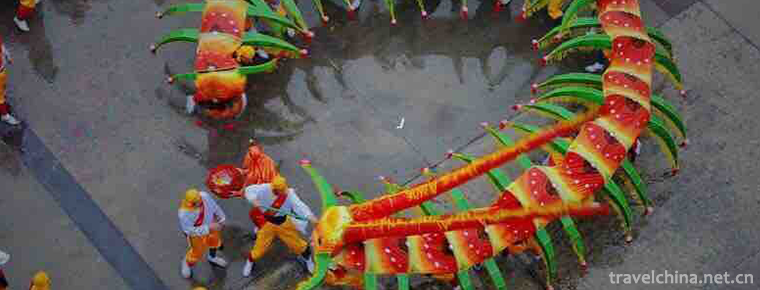Centipede dance
Centipede dance
Centipede dance, Guangdong traditional folk dance. Originated from Tongzhi in Qing Dynasty to Guangxu, it was initiated by Chen Chengjin, a native of Ximen, and Shi Wenyong, a good friend. It is a square dance of large animals. Once it was published, it has been popular and passed down to the present day. Now it is a traditional art exhibition project of Yonghe Garden of Ximen Community Residential Committee in Chenghai District, Shantou City.
In June 2008, the centipede dance declared by Chenghai District, Shantou City, Guangdong Province was listed in the second batch of national intangible cultural heritage list with the approval of the State Council.
historical origin
In Chaoshan Dance, the unique folk large square dance "centipede dance" was created by Chen Chengjin and Shi Wenyong in the Qing Dynasty. At that time, the Chenghai Goddess Tournament was very popular, and various parade programs appeared in competition. Chen Chengjin and Shi Wenyong, who are fond of folk dances, saw centipedes crawl and twist, which is very interesting, thus inspiring the creation of centipede dance. After a lot of careful research, the centipede body and a whole set of dance movements were designed and made for dancing. After continuous improvement and processing by later generations, it has become increasingly perfect. The whole length of Ximen centipede in Chenghai is 22 meters. It has three parts: head, body and tail.
The head is 1 metre long, the body is 18 metres long and the tail is 3 metres long. The head is composed of neck, nose and mouth, which resembles the "waking lion's head". There is a pair of sharp teeth on both sides of the mouth, two eyes set with transparent green lights, magnificent. The body is made of 28 pieces of hard and soft cloth frames, which are made of bamboo strips. Each section is 55 centimeters long and matched with two pairs, totaling 13 sections. The soft frame is only made of cloth, each section is 65 centimeters long, which is called "soft belly". In addition, it connects the first and last sections, totaling 15 sections. Dance flexibly and freely. The tail is scissors-shaped with two vines and covered with red silk. Head and body are painted with gorgeous colors. In addition to the main body, it is equipped with a spherical centipede bead.
artistic characteristics
Dance movements are designed to imitate centipede motions and movements. The centipede is an arthropod. The performers all dance in a semi-squatting position, using Wushu movements such as "double underneath Chang", "T-shaped horse", "single bow", "double bow", "single Qia", "Guanyin sitting lotus". When centipedes dance, they zigzag and zigzag, changing in thousands of ways, forming beautiful dancing gestures such as "3", "6", "8", "9", "water ripple", "four pillars of centipedes" and "plum blossom dots". At the same time, there are fast biting tail, turning stomach, spitting beads and other intense and difficult movements.
Beautiful dancing and bodybuilding martial arts are integrated, with great momentum and full of interest. The whole process of dancing is guided by colorful beads, and the whole centipede's eyes glisten. Thirteen sections of the waist were lit with candles, and a red tail rose high and swayed up and down. Plus fireworks to boost, beads habitually shoot. The climax is like a sunny sky, magnificent and pleasing to the eye. When performing, the accompaniments are often "Dragon Wagging Tail", "Out of Gate", "Flying Phoenix Title Book", "Liu Qingniang", "Underwater Fish", "White Character Blowing Drum" and folk minor.
The centipede dancer follows nature and forms a unique artistic form after several innovations. The performances were led by one person carrying beads, fifteen people holding centipedes, hiding under the belly of centipedes, bending down and bending legs, manipulating centipedes to wriggle and circle. It not only vividly imitates the shape and habits of centipedes, but also shows a strong, steady and magnificent atmosphere.
Current situation of inheritance
Centipede dance has a history of more than one hundred years. Through continuous evolution and improvement, it has special historical value in the study of Chaoshan traditional culture and folk worship. In terms of artistic value, centipede dance integrates music, dance and martial arts, with strong ornamental and spectacular scenes. As a messenger of cultural exchange, he has been invited to perform at home and abroad for many times. At the invitation of the Shantou Municipal Government in 1926, he performed in front of the Shantou Judicial Hall. In 1937, he went to Hong Kong to celebrate the coronation of King George VI and stirred up Xiangjiang. In 1987, he went to Guangzhou to attend 27 consecutive performances of the First Folk Art Joy Festival of Guangdong Province; in 2000, he participated in the 28th Major Cosmetic Parade of Singapore; in the same year, he won the 10th Square Dance Bronze Award of the Ministry of Culture.


-
1.Shanghai Museum of Natural History
The Shanghai Museum of Nature (Shanghai Science and Technology Museum Natural Branch) is one of the largest natural museums in China. Located in the center of Shanghai, Address: 260 Yan'an East Road,
Time 2018-12-15 -
2.Mianzhu New Year Picture Village Scenic Area in China
New Year Picture Village is located in Xiaode Town, South Gate of Mianzhu City, Sichuan Province. It is located between De'a Highway and Chengqing Highway, 73 kilometers away from Chengdu and within o
Time 2018-12-22 -
3.Drifting in Baotianbang Canyon
Baotianbang Canyon Drifting Scenic Area is located in Neixiang County, Nanyang City, Henan Province, which is an excellent tourist city in China. Baotianman is the only World Biosphere Reserve in Hena
Time 2019-01-02 -
4.Huaian Government Office
Huai'an government office is located in Huai'an City, Jiangsu Province, which is a national AAAA tourist attraction. It is located in Dongmen Street, Huai'an District, the old city of Huai'an, north o
Time 2019-01-17 -
5.Eight treasures porridge
Babao porridge is a dish of Manchu and Han Dynasty. It tastes sweet and delicious and enjoys a high reputation.
Time 2019-03-26 -
6.Cloth paste painting
Teng Teng is the founder of Teng's cloth paste painting. He was born in Fengning Manchu Autonomous County, Hebei Province in 1932. He is the director of Teng's cloth paste painting
Time 2019-04-04 -
7.dough figurine
Noodles, also known as face sculptures, models and flowers, are simple but highly artistic Chinese folk crafts. As early as the Han Dynasty, Chinese face sculpture art has been written down. It uses f
Time 2019-06-05 -
8.Nuo opera
Nuo Opera originated from Fang Xiangshi's exorcism activities in Shang and Zhou Dynasties. After Han Dynasty, it gradually developed into a ritual ceremony with strong entertaining color and opera mus
Time 2019-06-08 -
9.Wuyin Opera
Wuyin opera has a history of nearly 300 years. Its singing style is graceful and charming. It is known as "Northern Yue Opera". Its occurrence, development and finalization have gone through
Time 2019-06-29 -
10.Wuzuquan
Wuzu Quan is one of the Nanquan in traditional Chinese boxing. It is said that Cai Yuming (from Quanzhou, Fujian Province, 1853-1910) synthesized Baihe Quan, Monkey Quan, Arhat Quan, Dazun Quan and Ta
Time 2019-06-29 -
11.Yongxiu Yaya Opera
Yongxiu Ya Opera originated in Wu Town, one of the four famous towns in Jiangxi Province. It was born in the late Ming Dynasty and Ganbei Bench Opera. Because all of its female characters were played
Time 2019-07-14 -
12.Neijiang folk culture
Bull lantern dance is popular in Yuexi. One dressed as a shepherd boy and two dressed as cattle with cow shaped props. In the sound of gongs and drums, the shepherd boy first said doggerel to the audience to express the festival's congratulations, and then
Time 2020-12-16